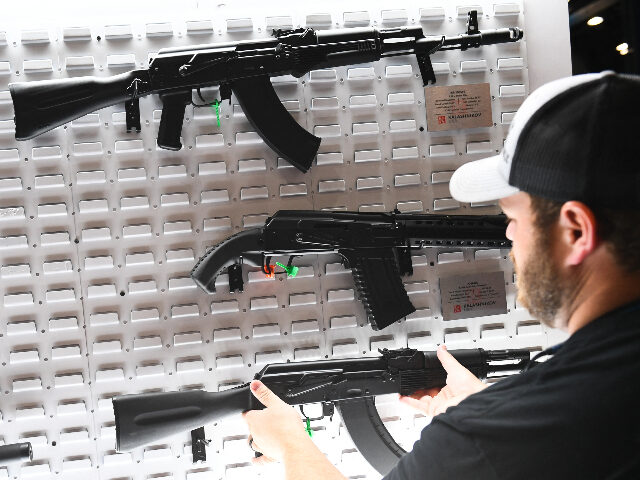U.S. District Court Judge Roger T. Benitez struck down California’s “assault weapons” ban Thursday but is staying the implementation of his decision for ten days to give California Attorney General (AG) Rob Bonta time to begin an appeal if so desired.
The Los Angeles Times indicates California adopted its “assault weapons” ban in 1989. Since then, the ban has been incrementally tightened, with more firearm types and more firearm features added to the ban.
The plaintiffs in the case–James Miller, Wendy Hauffen, Neil Rutherford, the Second Amendment Foundation, and the Firearms Policy Coalition, among others–argue that misuse of popular semiautomatic rifles, like AR-15s, is highly publicized, but defensive actions with such firearms get little press.
Benitez concurred, writing:
This Court understands the unquestionable tragedy caused by lawless individuals using modern semi-automatic guns or any gun to injure or kill innocent men, women, or children. Their lives are important. But are their lives any more important than Jane Doe’s or the lives of her family? We hear constantly about mass shootings for days and weeks and on anniversaries. But how often do we celebrate the saving of the life of Jane Doe because she was able to use a semi-automatic weapon to defend herself and her family from attackers? Are the lives of Jane, John, and Junior Doe worth any less than others? Are they less important?
Moreover, Benitez pointed out that the semiautomatics, which California lawmakers label “assault weapons,” are rarely used in crime in the Golden State:
In California, while modern semiautomatics are not rare, they are rarely the problem. For example, in 2022, only three “assault weapons” were used in violent California crimes, according to the Attorney General’s annual report, “Firearms Used in the Commission of Crimes.” For the preceding year, the report announced that only two assault weapons were used in violent crimes, while the 2020 report identified zero “assault weapons” used. Other government homicide statistics do not track “assault rifles,” but they do show that killing by knife attack is far more common than homicide by any kind of rifle.
WATCH: Here’s the Difference Between an AR-15 and “Assault Weapon”
ahawkinsBenitez further noted:
The State of California posits that its “assault weapon” ban…promotes an important public interest of disarming some mass shooters even though it makes criminals of law-abiding residents who insist on acquiring these firearms for self-defense. Nevertheless, more than that is required to uphold a ban.
He then turned to the Supreme Court of the United States’ Bruen (2022) decision, writing:
Bruen makes clear that, “[t]o justify its regulation, the government may not simply posit that the regulation promotes an important interest.” After all, “the very enumeration of the right takes out of the hands of government—even the Third Branch of Government—the power to decide on a case-by-case basis whether the right is really worth insisting upon.”
He took pains to follow Bruen’s framework for historical evidence of similar bans throughout American history and discovered that repeating rifles were actually protected in earlier decisions:
There appears to be no other law in the nation’s history that prohibited high capacity repeating rifles such as the Winchester lever-action repeater rifles or the Gatling gun. And at least one court around the time of the Fourteenth Amendment specifically protected repeating firearms. “[W]e would hold, that the rifle of all descriptions, the shot gun, the musket, and repeater, are such arms; and that under the Constitution the right to keep such arms, cannot be infringed or forbidden by the Legislature.”
Benitez brought Heller (2008) into the conversation as well:
Justice Alito took pains to point out that this is a conjunctive test. “As the per curiam opinion recognizes, this is a conjunctive test: A weapon may not be banned unless it is both dangerous and unusual . . . . If Heller tells us anything, it is that firearms cannot be categorically prohibited just because they are dangerous.” In Heller, the Supreme Court said the firearms that are protected are firearms “that are not dangerous and unusual and typically possessed by law abiding citizens for lawful purposes like self-defense.”
He concluded by deciding in favor of the plaintiffs, ordering that law enforcement not enforce California’s “assault weapons” ban. However, Benitez stayed his own decision for ten days to give AG Bonta time to appeal the decision if he so chooses.
The case is Miller v. Bonta, No. 3:19-cv-01537, in the United States District Court, Southern Court of California.
AWR Hawkins is an award-winning Second Amendment columnist for Breitbart News and the writer/curator of Down Range with AWR Hawkins, a weekly newsletter focused on all things Second Amendment, also for Breitbart News. He is the political analyst for Armed American Radio and a Turning Point USA Ambassador. He was a Visiting Fellow at the Russell Kirk Center for Cultural Renewal in 2010, a speaker at the 2023 Western Conservative Summit, and he holds a Ph.D. in Military History, with a focus on the Vietnam War (brown water navy), U.S. Navy since Inception, the Civil War, and Early Modern Europe. Follow him on Instagram: @awr_hawkins. You can sign up to get Down Range at breitbart.com/downrange. Reach him directly at awrhawkins@breitbart.com.

COMMENTS
Please let us know if you're having issues with commenting.